Mabie Todd Swan Visofil Filling System
by Jim Mamoulides With Laurence Oldfield, January 10, 2004
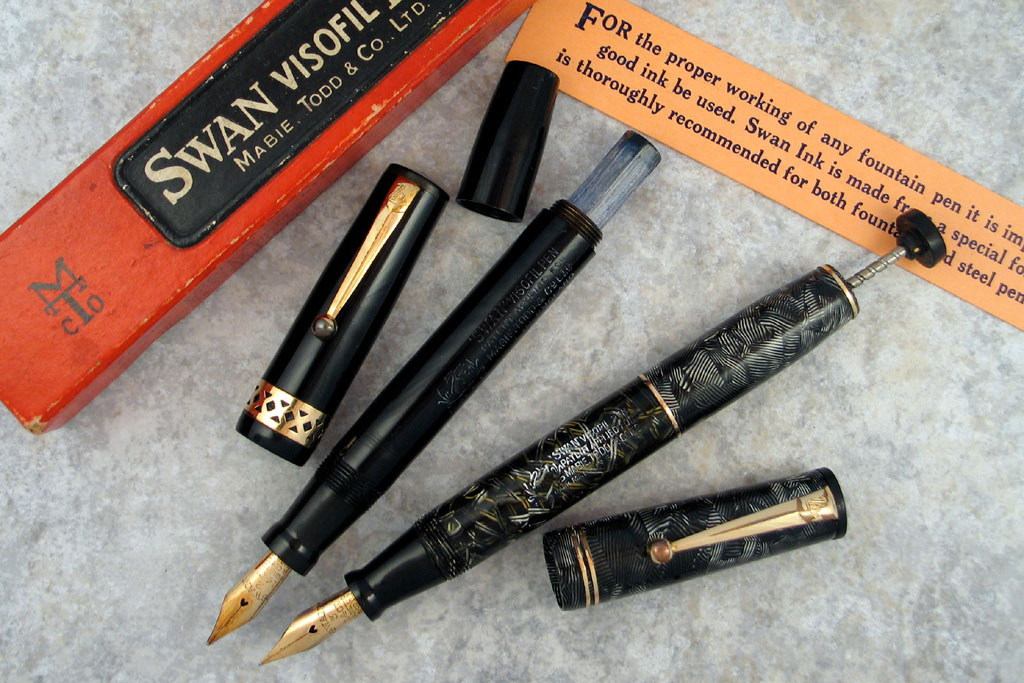 Left to right: Mabie Todd Swan Visofil V Series Black / Visofil VT Series Black and Grey
Left to right: Mabie Todd Swan Visofil V Series Black / Visofil VT Series Black and Grey
Two very unusual approaches
In spite of the Great Depression, the 1930s rivals the first decade of the Twentieth Century for new fountain pen design and new filling systems introduced. Where the earlier decade established the standard elements of the self-filling fountain pen in its complete form, including safety cap, clip, and advanced feed, the 1930s was a time of true and broad-based innovation with the intent to gain competitive advantage. Pelikan and Conklin early in the decade introduced piston filling pens, a type that exists today both as a filling unit and as a converter type. These designs were followed by other interesting filling solutions, including Sheaffer's Vacuum-Fil and Parker's Vacumatic, both introduced in1934.
 Mabie Todd Swan Visofil VT Series Black and Grey
Mabie Todd Swan Visofil VT Series Black and Grey
Unlike prior pens, a key selling point was the larger capacity offered by storing the ink directly in the barrel, eliminating the need for a sac. This was high tech stuff in the 1930s. Because of the sacless design, these new pens could be made with clear and translucent plastics, giving the added benefit of being able to easily see the ink level in the pen. This feature was so popular that manufacturers began to put ink view sections on lever-fill pens just to keep up, as seen on the Parker Televisor, for example.
Mabie Todd was, at that time, the third ranking pen maker in England behind De La Rue and Conway Stewart. Generally a market follower, having only just adopted more streamlined designs by as late as 1933, Mabie Todd must have felt the pressure from these innovations and got to work on new filling systems.
The 'V' Series Visofil - A Look Inside
According to Laurence Oldfield's article in the Journal of the Writing Equipment Society (UK), November 2002, Pen Mechanisms Revealed – 1. The Swan Visofils,
"The idea for the Mk 1 Visofil was patented in 1934 by Edward Sears and Mabie Todd and Company Limited (Fig.2) as an ‘ink visible pen with increased ink capacity’. The pen as actually produced differs only in detail from the patent . . . its operation is elegant and a natural development from pre-existing designs. The transparent hexagonal ink reservoir is an extension of the rubber sac and acts as a push button to compress the sac longitudinally against the action of a surrounding spring. The filler is prevented from rotating by a hexagonally bored brass bush fixed to the end of the barrel. This also provides attachment for the blind cap."
 Mabie Todd Swan Visofil 'V' Series Italian Marble Small Ladies' Model exploded view
Mabie Todd Swan Visofil 'V' Series Italian Marble Small Ladies' Model exploded view
Photo courtesy Laurence Oldfield
The Visofil V Series (Mark 1) is, effectively, a modified sac filling pen that uses a clear plastic plunger to compress and fill the sac. The action is physically much like the Parker Vacumatic pens, with the principal difference being the sac is still used to contain much of the ink, instead of merely acting as a diaphragm to create the vacuum needed to draw ink into the barrel.
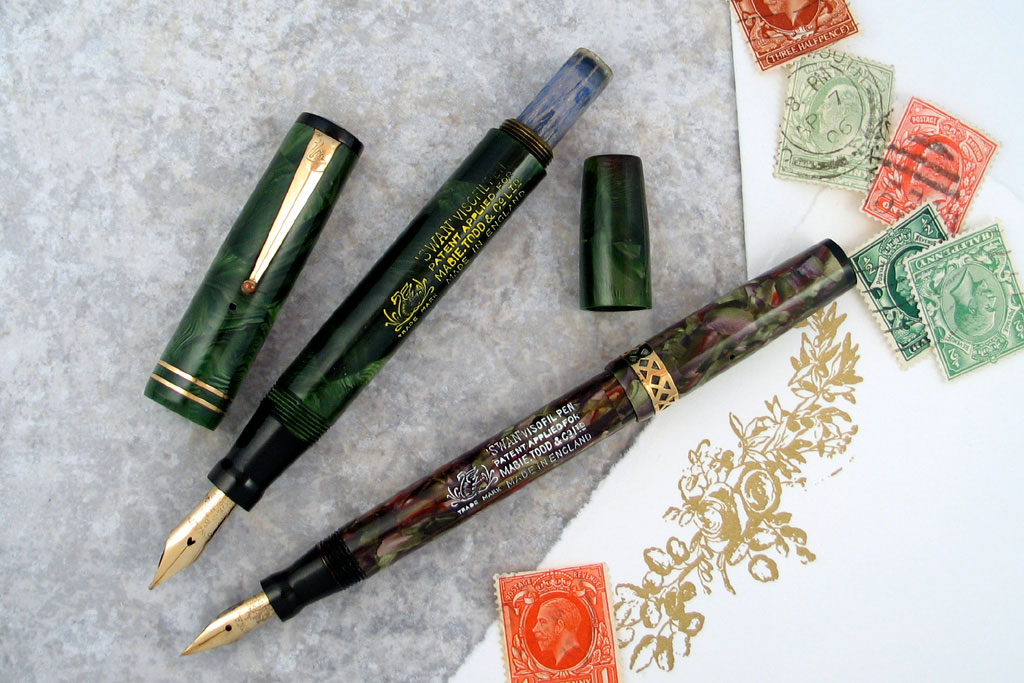 Mabie Todd Swan Visofil 'V' Series Emerald Green Marble, left and Ladies' Italian Marble Pen, right, c1935
Mabie Todd Swan Visofil 'V' Series Emerald Green Marble, left and Ladies' Italian Marble Pen, right, c1935
The V Series Visofil completely disassembles, including the cap, as shown in the two exploded view photos. This is similar to other Mabie Todd pens from this era with an exception. Because the filler plunger is held in by the brass bush mounted at the end of the barrel, the pen must be dismantled by first "removing the section (a little soaking and /or heat may be necessary), and then by pushing the filler down through the barrel." Once the pen is apart, without some knowledge of the filler mechanism, it still may not be obvious, even to experienced pen restorers, how to proceed.
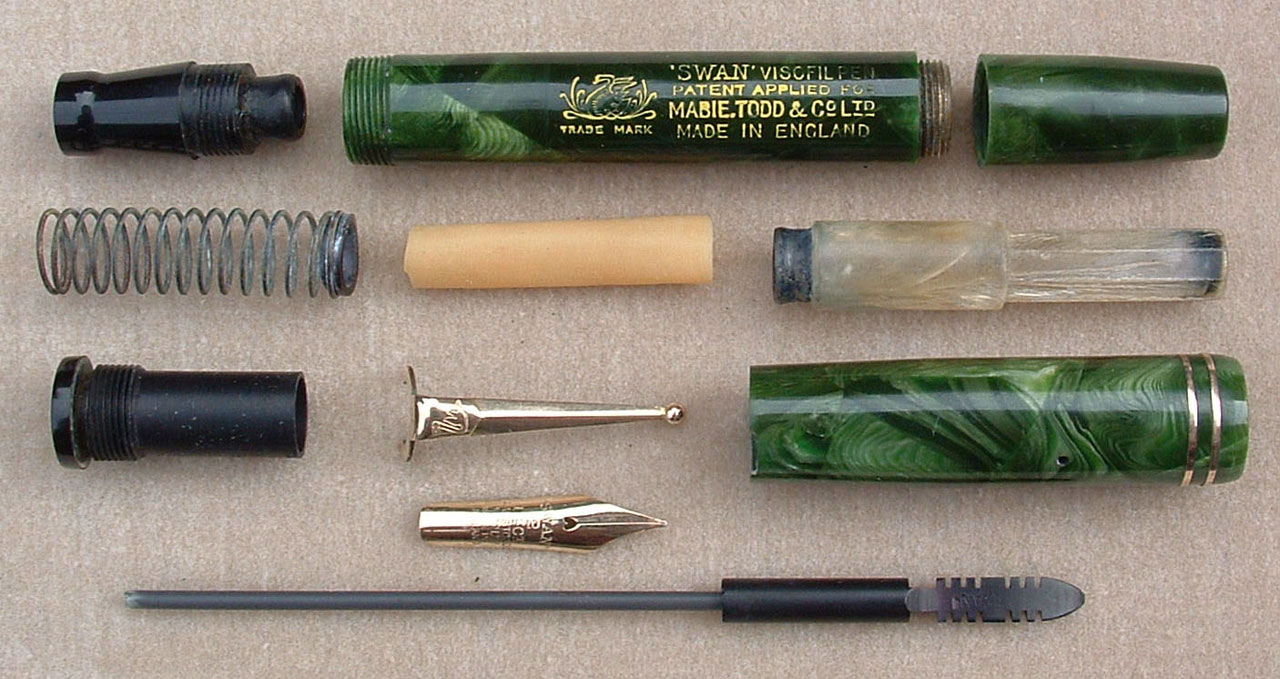 Mabie Todd Swan Visofil 'V' Series Emerald Green Marble exploded view
Mabie Todd Swan Visofil 'V' Series Emerald Green Marble exploded view
Photo courtesy Laurence Oldfield
The Emerald Green Marble V Series pen shown in this article was, at some point before our acquisition, incorrectly serviced by having the sac attached to the section nipple, as in any other sac filling pen. The repairer evidently had no knowledge of the Visofil's repair or operation, performed a routine sac replacement, and reassembled the pen, apparently assuming that the plunger was used to depress the closed-ended sac. This is an understandable mistake, and the repair resulted in very weak suction and a very poor fill.
The "trick" to the filling system is that the sac becomes a tube (see the photos) between the section and the plunger. Both have sac nipples, so the sac end needs to be cut off so that it can be attached to both. The spring surrounds the sac within the barrel, allowing for long travel, and simplifying the mechanics of the design. This allows the correct operation of the pen and allows ink to correctly flow into the plunger so that the ink level can be seen.
The 'VT' Series Visofil - A bit more complex
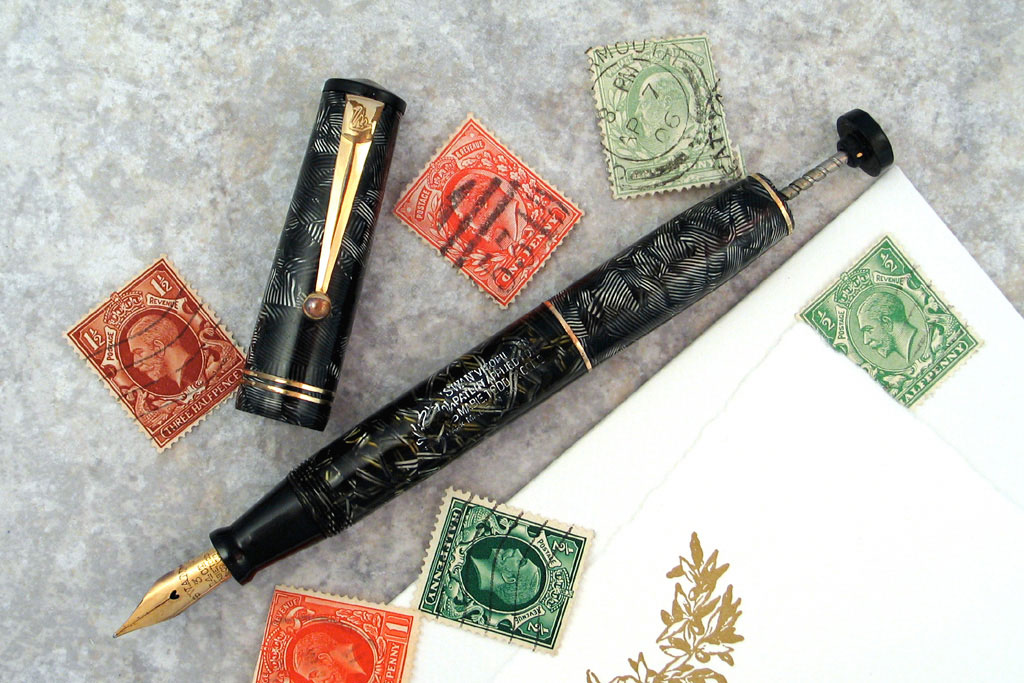 Mabie Todd Swan Visofil Visofil VT Series Black and Grey
Mabie Todd Swan Visofil Visofil VT Series Black and Grey
The 'VT' Series Visofil (Mark 2) was patented in 1936, as an improvement to the V Series models and likely also as a response to the immensely popular Parker Vacumatic. The principal differences are the use of the barrel to hold the ink, as with the Vacumatic, with the resulting need to redesign the plunger mechanism, as it has to be moved to the back of the barrel in order to make room for the ink chamber.
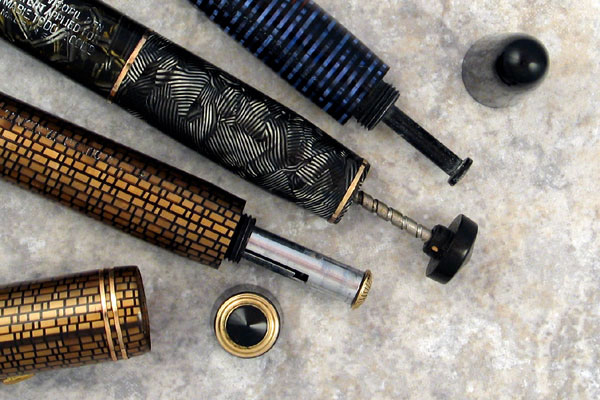 Detail of plungers (left to right):
Detail of plungers (left to right):
Parker Vacumatic Golden Web c1936-1937
Mabie Todd Swan Visofil Visofil VT Series Black and Grey
Parker Vacumatic Azure Blue c1941-1948
The pen still uses the sac "tube" as its filling method, but the sac attaches at the center of the barrel just past the visulated portion. The back opening of the sac attaches to the mounting for the square plunger rod with a ring, to make a watertight seal. The rod is square in order to prevent it turning while the plunger is being cycled. The rod and spring is mounted through the sac rather than outside it, as in the V Series, and is guided in an aperture at the base of the barrel. Unlike the Vacumatic, the Visofil VT Series has no blind cap. Instead, Mabie Todd inventors Leslie Johnson and Edward Sears devised a unique solution, "the extendable button (which) is certainly more elegant than the easily lost blind cap."
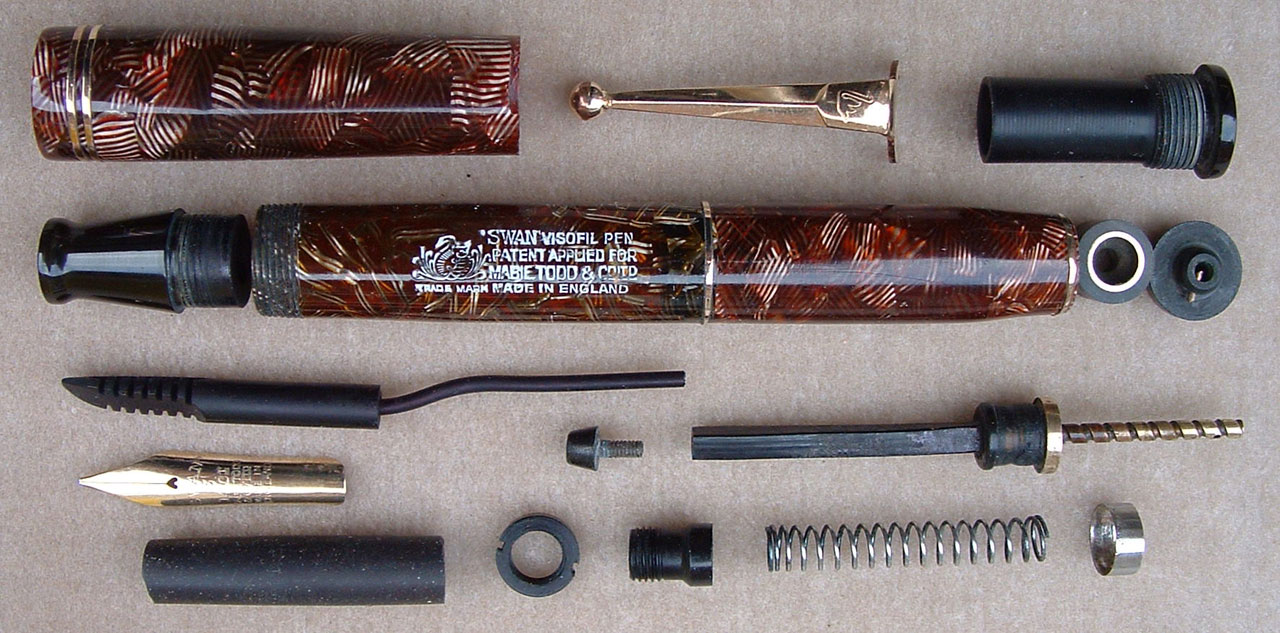 Mabie Todd Swan Visofil 'VT' Series Ruby and Silver exploded view
Mabie Todd Swan Visofil 'VT' Series Ruby and Silver exploded view
Photo courtesy Laurence Oldfield
The VT Series also completely disassembles, but it's a more difficult job, as described in Laurence Oldfield's article,
"A special tool is required to unscrew the nut to enable the mechanism to be pulled out of the end of the barrel. This is the most difficult part of the repair as the application of reasonable heat is rarely sufficient to release the bush. Assuming that a replacement bush can be made, the old one can be drilled or turned out following removal of the plunger button. After releasing the diaphragm-retaining ring and clearing any debris from the old filler, the condition of the return spring needs to be assessed."
The barrel is of two pieces, the part near the section is transparent and provides the ink chamber, the back end conceals the filling mechanism and is the same plastic, in opaque. These two pieces are glued together and cannot be taken apart. Attempting to do so may damage the pen.
Unrestored VT Series pens are even less intuitive than the V Series above. It is possible that an experienced restorer may work out how to disassemble, repair, and reassemble the V Series pen, especially after seeing it correctly taken apart. A VT Series pen may actually have to be drilled out to remove the filler bushing and a replacement created. This pen type should be repaired with the correct tools and instructions.
Dr. Oldfield sells the specialized tools and the detailed instructions needed for the job, and they are illustrated on his website, The Pen Practice. He also repairs and restores these unique pens.
Acknowledgement
Grateful thanks to Laurence Oldfield. His knowledge of the Visofil pen, Visofil repair and restoration, extensive research, and superb exploded view photographs made this more of an editing job than a difficult from scratch writing job. I may have assembled this article, but he is as much, if not more the author. As with the other Visofil article on PenHero.com, a great deal of the information used to update this article, especially technical details and model information, is from his article, Pen Mechanisms Revealed - 1. The Swan Visofil, and is used with the permission of the author. Dr. Oldfield repairs Visofils and can be contacted at his website, The Pen Practice.
Interact
Comments on this article may be sent to the editor, Jim Mamoulides


